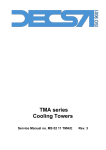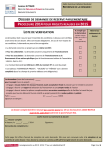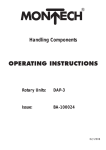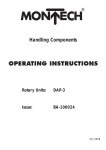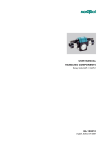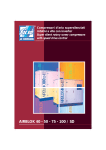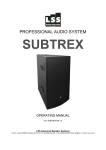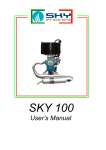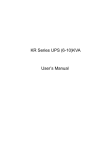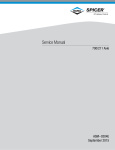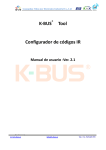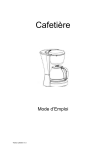Download Cooling towers series TMR
Transcript
Cooling towers series TMR Service manual n. MS 12 00 TMR/E INDEX Important safety information Pag. 2 Description of the machine Pag. 5 Location Pag. 7 Reference to models Pag. 11 Shipment Pag. 12 Lifting Pag. 13 Reassembly Pag. 15 Installation Pag. 18 Start-up Pag. 21 Operation Pag. 23 Maintenance Pag. 24 Setting out of service and dismantling Pag. 31 Thank you very much for purchasing our equipment and be sure to carefully read this manual before using the machine. The series TMR cooling towers models 09 - 450 comply with the European Community rules n. 89/392/CEE, 91/368/CEE, 93/44/CEE and 93/68/CEE. - 1IMPORTANT SAFETY INFORMATION Caution Please read carefully this manual before using the machine. You will find important information to safely use the machine. Caution The machine must be grounded. For protection during a lightning storm or when the unit is left unattended and not used for a long time, turn off the power supply to the unit. This will prevent the unit from damage due to lightning or power line surges. Caution After connecting the motors, check for the correct rotation of fans. Caution Do not approach the unit when it is operating. Beware of corners and edges. Danger Never introduce hands of foreign matters in the air inlet and outlet of the machine. Danger Never open inspection doors when the machine is in operation. Danger The maintenance operations should never be accomplished when the unit is in operation. Be sure that the machine has been disconnected before entering the dangerous area or inside the machine. Caution The hot and humid ambient may favour the growth of micro-organism. For specific recommendations consult a specialised water treatment supplier. Caution The recirculating water system may contain chemicals or biological contaminants, which could be harmful if inhaled or ingested. Accordingly, personnel who may be exposed directly to discharge airstream and associated drift, mists generated during operation of the water distribution system and/or compressed air should these be used to clean portions or components of the recirculating water system, should wear respiratory protection equipment approved for such use by local occupational health and safety authorities. Location -2- Each cooling tower should be located and positioned to prevent the introduction of discharge air into the ventilation system of the building on which the tower is located and of adjacent buildings. Biological control Blow down with or without chemical treatment for scale and corrosion control is not adequate for control of biological contamination. The growth of algae, slimes and other micro-organisms, if unchecked, will reduce system efficiency and may contribute to the growth of potentially harmful micro-organisms, in the recirculating water system. Accordingly, a biocide treatment programme specifically designed to address biological control should be initiated when the system is first filled with water and administered on a regular basis thereafter in accordance with supplier's instructions. For specific recommendations consult a competent water treatment supplier. -3Description REFERENCE TABLE Reference number Material Electric motor Supports with bearings Centrifugal fan Float valve Water filter Make-up valve Motor pulley Transmission belt Fan pulley Secondary header Drift eliminators Wet deck fill Gasket for header Spraying nozzle -4DESCRIPTION OF THE MACHINE 1 2 3 4 5 6 7 8 9 10 11 12 13 14 Metal Metal Metal Polypropylene Metal Brass Metal Rubber Metal Polypropylene Galvanised steel PVC Rubber Rubber The purpose of the series TMR cooling towers is to cool water by means of the evaporative principle, that is rejecting heat by evaporating a small percentage of the water itself. The main components of the unit are essentially the water sump, inlet air grills, evaporating fill, headers and nozzles for spraying water, drift eliminators, centrifugal fans complete with transmission and electric motor, casing. The water is supplied to the tower by connecting it to a system with circulating pumps, connected to the users. From the inlet header the water is distributed through a spraying system to the upper part of the fill, through it flows to the sump. At the same time the air blown by fans is pushed in counter current through the fill upside; the air stream boosts the evaporating process rejecting the heat from water. From the sump, the water is exhausted in a closed circuit, going back to the users. -5- TECHNICAL DATA Model Air Number Number Power flow of fans of each motors Ambient wet bulb temperature °C (2) 22°C motor 26°c inlet/outlet water °C KW (1) m3/s 24°c 35/29 45/30 35/30 45/30 35/30 KW Power Power electric electric heater heater KW (3) KW (4) 45/31 Pa 0- 50 Pa 100 KW KW KW KW 09 2,19 1 1 0,75 1,5 101 171 90 149 70 KW 138 0,5 1 12 2,43 1 1 1,1 2,2 138 244 123 214 97 198 0,5 1 13 2,67 1 1 1,5 2,2 151 266 134 233 106 215 0,5 1 14 2,83 1 1 2,2 3 180 328 160 290 128 268 0,5 1 16 3,33 1 1 1,5 2,2 189 334 168 293 133 271 1 2 18 3,78 1 1 2,2 3 212 373 188 327 148 302 1 2 21 4 1 1 3 4 253 460 224 406 179 376 1 2 24 5 2 1 3 4 284 500 252 439 199 406 2 3 28 5,67 2 1 4 5,5 318 560 283 490 223 453 2 3 31 5,83 2 1 5,5 7,5 382 703 338 623 271 577 2 3 34 7,13 2 1 4 5,5 402 708 357 621 282 574 2 3 38 7,99 2 1 5,5 7,5 446 784 396 687 312 634 2 3 41 7,56 2 1 5,5 7,5 480 873 425 772 340 714 2 3 44 8,2 2 1 7,5 11 518 941 459 831 367 769 2 3 51 10,36 3 1 5,5 7,5 586 1033 521 906 411 837 3 4 56 11,33 3 1 7,5 11 635 1118 565 980 445 905 3 4 61 11 3 1 7,5 11 700 1275 620 1127 495 1043 3 4 66 11,67 3 1 11 15 739 1344 655 1187 523 1099 3 4 70 14,26 4 2 4+4 5,5+5,5 803 1416 715 1242 563 1147 3 4 76 15,98 4 2 5,5+5,5 7,5+7,5 891 1567 793 1373 624 1268 3 4 83 15,11 4 2 5,5+5,5 7,5+7,5 959 1746 850 1542 679 1428 3 4 88 16,42 4 2 7,5+7,5 11+11 1035 1882 918 1662 733 1538 3 4 94 19,33 5 2 5,5+7,5 7,5+11 1081 1902 962 1667 758 1540 2+2 3+3 103 18,56 5 2 5,5+7,5 7,5+11 1179 2147 1046 1898 835 1756 2+2 3+3 109 19,88 5 2 7,5+11 11+15 1256 2285 1114 2019 889 1868 2+2 3+3 122 22 6 2 7,5+7,5 11+11 1399 2549 1241 2252 991 2085 3+3 4+4 132 23,34 6 2 11+11 15+15 1478 2689 1311 2375 1046 2198 3+3 4+4 58 12,1 1 1 7,5 11 683 1206 608 1057 480 977 3 4 64 13,61 1 1 11 15 761 1339 677 1173 533 1084 3 4 74 13,99 1 1 15 18,5 884 1607 784 1420 626 1313 3 4 112 23,45 2 1 15 18,5 1328 2345 1182 2057 932 1901 4 5 125 24,95 2 1 18,5 22 1405 2478 1250 2173 986 2007 4 5 134 24,2 2 1 18,5 22 1545 2819 1370 2492 1094 2306 4 5 144 25,7 2 1 22 30 1634 2978 1449 2632 1157 2434 4 5 160 28,73 2 1 30 37 1811 3293 1607 2908 1282 2691 4 5 180 35,14 3 1 22 30 1991 3515 1771 3084 1397 2848 5 6 210 37,42 3 1 30 37 2384 4347 2114 3842 1688 3555 5 6 225 39,7 3 1 37 45 2518 4586 2233 4052 1783 3749 5 6 250 49,89 4 1 18,5+18,5 22+22 2811 4955 2500 4345 1971 4013 4+4 5+5 265 48,39 4 1 18,5+18,5 22+22 3089 5638 2740 4984 2189 4612 4+4 5+5 280 51,39 4 1 22+22 30+30 3267 5953 2897 5261 2314 4868 4+4 5+5 310 57,46 4 1 30+30 37+37 3623 6585 3214 5816 2564 5380 4+4 5+5 335 63,12 5 2 22+30 30+37 4017 7325 3563 6473 2846 5989 5+5 6+6 360 66,15 5 2 30+30 37+37 4196 7642 3722 6751 2971 6247 5+5 6+6 375 68,43 5 2 30+37 37+45 4330 7879 3841 6960 3065 6439 5+5 6+6 415 74,84 6 2 30+30 37+37 4767 8694 4228 7684 3377 7110 5+5 6+6 450 79,39 6 2 37+37 45+45 5036 9171 4467 8103 3566 7497 5+5 6+6 LOCATION TMR cooling towers offer maximum flexibility of installation. Vertical air discharge ensures that the operation of tower is not affected by wind strength and direction for outdoor installation while the high static pressure capacity of centrifugal fans makes it possible to install TMR towers inside closed spaces with ducted air intake and/or discharge. It is necessary, however, to keep in mind some basic installation rules which, if not observed, will impair correct operation of the cooling tower. No matter where the tower is installed, it will be necessary to leave enough space around the tower for maintenance operation; maximum accessibility is specially needed at the water connections and at the inspection manhole. In outdoor installations it is extremely important that the air intakes to the fans are not obstructed; the tower should be placed so that walls or other obstacles are at a distance from the intake grilles at least equal to the grille eight (see Fig. 1). Figure 1 -7- A cooling tower should not be installed close to walls or obstacles higher than the tower itself as in certain weather conditions this could cause recirculation of the discharged air. If this is absolutely necessary, a discharge air hood should be installed to increase the discharge air velocity (see Fig. 2). On the water connections side, or on the opposite side, it will be necessary to leave a space equal to the length of the fan shaft so that, if necessary, the shaft can be extracted for replacement of bearings or fan wheels. In installations with ducted air, sufficiently large inspection openings on air intake and discharge ducts are necessary for easily reaching the inside tower. The access to discharge ducts is for reaching spray nozzles, after removing drift eliminator, and the one to intake ducts for periodical checks of the fans (see Fig. 3-4). Ducts should be so constructed as to give a minimum pressure drop, with a low number of wide radius curves. Horizontal stretches of ducts should be slightly sloping towards the tower so that any water droplets, which might escape the drift eliminator, will flow back to the tower. If the air intake and discharge openings are to be ducted, care must be taken to place the openings of the inlet and outlet ducts as far as possible from each other to avoid any recirculation of moist air; a good solution would be to place these openings on different walls. In most cases it will be convenient to use only discharge ducts, air intake being made through sufficiently large openings in the walls of the room where the tower is installed, bearing in mind the previous remarks about relative location of air inlet and outlet. -8- Figure 2 -9- Figure 3 Figure 4 - 10 - REFERENCE TO MODELS In the following pages we give instructions related to different typologies of the models of the series TMR. To make the instructions easier, we will refer to the following model groups: A = 09 12 13 14 B = 16 18 21 28 28 31 34 38 41 44 51 56 61 66 70 76 83 88 94 103 109 122 132 C = 58 64 74 112 125 134 144 160 180 210 225 250 265 280 310 335 360 375 415 450 - 11 - SHIPMENT TMR cooling towers - groups A and B models - are normally shipped completely assembled to facilitate transportation and installation. The models of group C are normally shipped divided horizontally in two sections: the upper section includes the wet deck fill, the water distribution system and the drift eliminator; the lower section includes the water basin with the relative connections and the fan section. The reassembly operations at the site shall be carried out at Buyer's care and expense, following our instructions. Any accessory equipment, such as silencers, marine ladders, railing, etc., shall be always shipped disassembled and also their reassembly at the site shall be carried out at Buyer's care and expense. Shipment in one section of these towers must be especially requested when placing order. The towers divided in two sections are delivered along with a sufficient special gasket and the bolts necessary for the reassembly. - 12 LIFTING Group A and B models These models can not be divided and are equipped with 4 or 6 lifting devices in the upper part of the unit, which allow to lift the all unit (see Fig. 8 and 8/A). Group C models These models are equipped with two sets of lifting devices, one in the upper part of the unit and another one inside the lower section. The first one must be used to lift the all unit and the second one to lift the lower section only, when this is separately shipped. In both cases lifting should regard only small movements or the final positioning, while for extended lifts, such as from ground to the top of buildings, a suitable platform under the unit should be used (see Fig. 5) - 13 - Figure 5 - 14 REASSEMBLY When re-assembling, proceed as follows : a) b) c) d) e) f) g) Place the lower section of the unit on a flat surface, being sure that the upper edge has not been damaged during transportation. Cut a suitable length of gasket, remove paper protection from one side and press gasket onto base top flange. Remove paper on the other side and drill holes in the gasket in correspondence of the edge holes. Place the bead sealer over the tape sealer in the area between the holes and the inside of the unit (see Fig. 6). Lift (according to the instructions of paragraph "Lifting") the upper section of the unit and place it in position with the help of metal pins into the holes of upper and lower flanges. If the holes do not correspond, it means that either the lower or the upper section of the unit are not flat; this may depend by the support platform or by the way of hoisting the upper section while assembling it. In some cases, if it proves to be difficult to obtain perfectly flat surfaces, it may be more convenient to re-drill some of the holes. In this case be sure to previously remove the gasket from the holes. It is necessary to perfectly centre all the holes before lowering the upper section (Fig. 7 and 7/A). Push bolts into position, and tighten. Connect the plastic by-pass pipe to the manual valve on the over-flow connection. If the tower is supplied complete with silencers on the air outlet, their reassembly must be effected following the above mentioned instructions. Figure 6 - 15 - Figure 7 Figure 7/A 1) Guide pin 3) Flat gasket 2) Round gasket Use 2 pins for each corner - 16 - Leakage sealing During transportation and lifting the units can be submitted to stresses that damage the sealing, which will result in water leakage during operation. Proceed as follows: 1) Sealing must always be made from the inside part of joints. 2) Seal only perfectly dryed surfaces. 3) Remove previous sealants. 4) Accurately degrease. 5) Do not seal only the area where a leakage is taking place, but largely exceed at the two sides. 6) Apply the sealant in a sufficient quantity, but not excessive, and as uniformly as possible. 7) If necessary, slightly press the sealant to allow the penetration between the surfaces. 8) Do not use the unit for at least 24 hours. If the sump has been sealed, it is advisable to protect the unit with plastic sheets to avoid rain to get inside the unit. Of course, use only suitable and good quality sealant. Our Engineering Department will be glad to give you all the suggestions you may need. - 17 - INSTALLATION It is necessary that the floor on which the tower is installed will be able to bear its operating weight (therefore with water in the tower), as indicated in TMR catalogue. TMR towers, as a rule, do not need any special foundation, having a sturdy base frame which must, however, rest uniformly on a perfectly levelled and horizontal base. For foundation bolts please refer to the base drilling of our Technical Bulletin. If the tower must be installed on metal profiles, with or without the interposition of shock-absorbers, closed and adequately dimensioned frames will be necessary. If towers are installed on top of buildings where noise or vibrations must be avoided (hospitals, hotels, etc.) it is absolutely necessary that towers rest on metal profiles, employing shockabsorbers between the metal profiles and the foundation (for shockabsorbers size please contact manufacturers). It is also advisable to place suitable shock-absorbing joints on water connections and air ducts, if there is any. As cooling towers are normally placed in the open air and often on top of buildings, it is necessary to take precautions against wind action. The base frame should be anchored by means of bolts and steel wires should be connected to the upper lifting ears. Mod. A Mod. B - 18 - Mod. C As far as water connections are concerned, they depend mainly on the particular installation and general rules cannot therefore apply. We suggest however as follows: Caution - - While welding the flanges to water inlet and outlet joints, care must be taken not to damage panels painting and sealing, wet deck fill and nozzles. For this put wet rags at joints base. The tower must be placed on the highest point of the water circuit to avoid emptying the system when the pump is stopped. If this is not possible, a check valve on the water outlet and an air relief valve must be fitted. Water circulating pumps must always be placed at a lower level than the water one. Water pipes must be properly sized and installed so that they can normally expand. In installations with two or more towers, care must be taken to balance pressure drops in the various pipe branches and level equalisation pipes must be connected to sumps. Make-up pressure drop must be at maximum of 2 Bar. Maximum operating pressure at water inlet connection must be 0,8 Bar. Higher pressure values may seriously damage internal distribution system of the machine. Before to tighten the bolts and nuts of the flanged connection, test the alignment and the flatness of the flanges. It is also advisable to put shut-off valves before each tower to enable separate maintenance of each tower; these valves are also useful to even out differences in water flow to each tower. As far as electrical connections are concerned, the following rules apply: a) Fan motors up to 7,5 kW size are suitable for electrical connection with direct start. For bigger size fan motors, soft start systems as delta/star must be foreseen to prevent excessive wear of the motors and of the transmission system (if any). If two speed motors Dahlander type are installed, motors must be started at low speed and switched at high speed immediately after. b) If the motor of the cooling tower is remotely controlled by a centralised control panel, it is advisable to install an isolating switch in the immediate vicinity of the tower for the complete safety of any maintenance operation. c) For winter operations it is advisable to install electric heaters (with safety thermostat) in the tower sump in order to be sure that all the water contained in the sump cannot freeze. Separate electric wiring from the motor is necessary. - 19 - Sump heater must be controlled by an independent thermostat (not included in our supply), follow-up linked to the pump remote control switch and adequately protected against short-circuiting. The bulb of the heater thermostat must be placed in the water sump, as far as possible from the electric heaters and near the sump bottom. d) Motors connection. The electric motors installed on our evaporative cooling equipment are normally insulated in class F with IP55 protection. This high protection grade is the best guarantee of good and long lasting operation in the humid ambient where normally the motors are installed. However it is important that while connecting the motor, a particular care is given to the tight fastening of the cablepresser of the terminal box and to the fastening of the cover of the same terminal box. A bad fastening of the cablepresser and/or of the cover of the terminal box, would make the motor subject to water infiltration, which would seriously damage the bearings and the windings. Even if the following are only general rules of good technique, we wish to remind that after having connected the motor, it is important to check that: 1) the connection is in accordance with the electric characteristics with which the motor should operate and the rotation is correct; 2) the cable-presser is perfectly tightened preventing any water infiltration; 3) in case the connecting box has a number of holes for wires, the ones that are not used should be tightly closed with an hermetic plug; 4) while reassembling the cover of the terminal box, the gasket should be correctly placed so as to ensure perfect tightness. Do not operate the unit if the above conditions are not accomplished. e) All electrical connections must be effected according to local regulations. Caution If the fan motor is controlled by an inverter (frequency variator), please pay attention on its programming, to avoid the operation at “critical” speeds. START-UP - 20 - Each unit is tested at the factory before shipment, however the following items should be checked prior to initial start-up: - if the float valve has been secured for shipment, free it; - check that the fans are free to rotate in the right direction; - if the drift eliminators are of the metal type, and they have been removed for any reason during transportation and installation, check that they are replaced with the air outlet edge oriented opposite to the fan section (see Fig. 8): Figure 8 - 21 - The float valve on the make-up water connection is adjusted at the factory, but it may be necessary to check for proper operation. The float valve should be completely closed when the level in sump is approximately 20 mm. below the overflow connection. Conversely the water level should not be too low, as this should enable air to be drawn into the pump, which would cause rapid wear of the impeller. Moreover the insufficient water sprayed over the fill would cause reduced efficiency and rapid scaling. During the initial period of operation, foreign matter deposited in the sump may reach the nozzles. It is therefore advisable to frequently clean the nozzles during the initial period of operation as irregular or reduced sprays may reduce the efficiency and increase scaling. - 22 OPERATION It is important that attention is given to quality of water to avoid build up of scale, which reduces the heat exchange and consequently the equipment efficiency. As water is sprayed over the fill, a portion of it evaporates, thus increasing the salts concentration in the remaining portion. A purge connection is supplied with each unit, which allows to increase the quantity of fresh water coming into the sump. This dilutes the salts reducing the scaling effect of water. The purge pipe is complete with a valve that should be regulated in accordance with the water hardness. As the quality of water is so important for the operation of an evaporative cooling unit, we strongly recommend to contact a specialised company asking for a suitable water treatment. Reputable water treatment companies are perfectly aware of the problems connected with evaporative cooling equipment and will suggest the proper treatment. Please note that the warranty for TMR units is valid only for operation with water of very good quality. - 23 MAINTENANCE Due to their location, normally in the open air, cooling towers although being relatively simple machineries, are usually subject to very adverse operating conditions. The TMR towers have an excellent protection from atmospheric corrosion since they are fabricated from hot dipped galvanised steel and then coated with baked-on epoxy paint. The electric motors and bearings are water tight and specially constructed for outdoor operation. These features reduce greatly the need for maintenance, but inevitably, to extend good performance of the tower through the years, some maintenance service operations must be effected regularly. Listed below you will find the main maintenance operations that must be regularly effected. Please note that the indicated frequency may have substantial variations depending on the particular operating conditions of the unit. OPERATION 1) Sump and water filter flushing 2) Water level and valve adjustment 3) Nozzles inspection 4) Fill check 5) Belt tensioning 6) Check bleed water 7) Check vibrations 8) Periodical fan operation 9) Bearings 10) Painting 11) Sump draining Monthly X - 24 1) Basin and water filter flushing X X X X 6 months Annual X X X X X X Empty the basin so as to eliminate every impurities. Clean the water filter removing it if necessary. 2) Valve and water level check Check the ball valve to make sure that its operation is correct. Tighten the bolts if necessary. 3) Nozzles inspection Inspect nozzles to be sure that all of them give a full and continuous spray and are not obstructed or scaled by foreign matters. If necessary, remove the nozzles; this operation can be accomplished without any tool as the nozzles are in rubber and can be disassembled by pulling them gently with alternate rotations. The reassembly operation can be made easier wetting the connecting collar. 4) Check fill surface As scaling would build up because of improper water treatment and/or irregular sprays, a frequent check of the fill may save considerable damage to the unit. Uniform scaling would mean that water treatment is not correct, while localised scaling means that one or more nozzles are not properly spraying. 5) Belt tensioning Belt tensioning is needed the first time after about 12 hours of operation, and monthly after that. Electric motors are installed over platforms fastened by bolts that must be loosened for tensioning belts. The correct tension can be checked by depressing each belt at the central point between the pulleys; the deflection should be between 10 and 15 mm., depending on the distance between pulleys and applying a moderate effort. If the unit has a seasonal operation, at the end of the season it is advisable to completely loosen the belts, which will increase their life. If belt replacement is necessary, purchase spares according with the type of belt stamped on the nameplate of the unit. Caution Over-tensioning of belts may damage the motor and fan bearings, while loose belts will slip, reducing equipment efficiency and increasing belt wear. 6) 7) Check bleed water The bleed water pipe is complete with a valve that should be regulated according with the conditions of water. Check vibrations - 25 - Any fault with the fan, both centrifugal and axial, and/or electric motor, will result in vibrations of the unit. If this occurs, immediately stop the unit and check the reasons of vibrations. This may save serious damage to the unit. Also the water recirculating pump should be checked for vibrations. 8) Periodical fan operation If the unit is not operating for long periods of time, it is necessary to foresee the periodical start-up of fan(s), in order to prevent the excessive drying of bearings and gaskets. 9) Bearings Some of the bearings used for the shaft of centrifugal fans are life lubricated and do not require additional lubrication under normal conditions. If the bearings have a lubrication connection, proceed as follows: Initial start-up: normally no lubrication is required since the bearings have been lubricated at the factory prior to shipment. However, if the unit has been stored at the jobsite for more than one year, bearings should be purged with new grease before initial operation Seasonal start-up: purge the bearings with new grease prior to start-up. Operation: lubricate bearings after every 2.000 hours of operation or once every six months, whichever comes first. Seasonal shut down: purge bearings with new grease prior to any prolonged storage or downtime. When lubricating, purge the old grease from the bearing by gradually adding grease until a bread of new grease appears at the seal on the underside of the bearing. We suggest to use grease with the following characteristics: - field of temperatures: from -20°C to + 110°C - kinematics viscosity of the base oil: 190 mm2/s - consistency (NLGI): 2 If the bearings are noisy, or vibrate or reach high temperatures, they should be serviced or replaced. 10) Painting Thoroughly check all the painted parts of the unit to detect possible areas where rust or corrosion has occurred. In this case, clean the part with a metal brush and apply a rust treatment product, such as Ferox of Arexons, Noverox, etc. . These products will convert rust into inert salts (follow manufacturer instructions). - 26 - After two or three days, remove product residue, if any, and apply good quality enamels compatible with the existing one. Normal protection units have a final coating with epoxy enamel, while Decsaprot double protection units have a final poliuretanic coating. 11) Sump draining Units with seasonal operation should be drained at the end of the season to avoid freezing. If the unit is shut down during the winter season, it is advisable to protect it with a water-tight covering. IDENTIFICATION DATA TMR units have a nameplate indicating the model and the serial number. For any information or spare parts requirements it is necessary to refer to them. - 27 - FAILURE CAUSE The fans do not run. No tension to the motor. The motor is blocked. The fan is blocked. The transmission is without belts. The fans vibrate. Unbalanced fan impeller. Loosened keying. The fans operate, but blow Backward rotation. insufficient air. Clanging fans. The impeller strikes against the casing. Loosened keying. The motor is noisy. Damaged ball bearings. If the noise is magnetic, faulty motor. One phase is missing. The motor is superheated. Faulty motor. Electric supply not correct. Overload. The belts slide at start-up or Insufficient tensioning. during operation. One or more nozzles do not Clogging. spray. One or more nozzles spray Partial scaling or clogging. irregularly. The evaporating fill is uniformly The circulating water is scaling. scaled. The evaporating fill is scaled in The water distribution is not some areas. uniform. The water cooling is Probable scaling of the fill, or insufficient. reduced air flow from the fans. REMEDY Fix the electric connections. Clear the motor. Clear the fan. Balance the impeller. Fix the keying on the shaft. Fix the electric connection so as to obtain the correct rotation. Repair the casing or the impeller. Fix the keying. Repair the motor. Check the connection. Repair the motor. Check the electric supply. Check the transmission. Replace belt tensioning. Remove the clogging. Clean the nozzles. Treat the water. Check the nozzles to obtain a uniform water distribution. Totally or partially replace the fill. Check the fans. Water carryover at the drift Excessive air flow. Reduce the air flow. eliminators. Eliminators incorrectly placed. Check the drift eliminators. Water leakage along the Damage to sealing during Replace water tightness in panels connections. transportation and/or accordance to the instructions installation. at page 19 Excessive water bleeding from Make-up ball valve too opened. Check the ball valve. overflow. The water level in the sump is Make-up ball valve too closed. Check the ball valve. much lower than the overflow. The water intake in the sump Too low water level. Check the ball valve. drags air (cavitation). - 28 - COMPONENTS LIST Models TMR Electricmotor Complete fan 15/1 Complete fan 15/2 Centrifugal impeller 18/25 Centrifugal impeller 18/40 Fan pulley Motor pulley Impellers shaft 25 Impellers shaft 40/2 Impellers shaft 40/3 Supports with bearings 25 Supports with bearings 40 Transmission belts Secondary header 85 Secondary header 115 Secondary header 175 Secondary header 235 Secondary header 295 Secondary header 355 Gasket for header Nozzles type 20 Wet deck fill 900 Wet deck fill 1200 Drift eliminators 450 Drift eliminators 600 Water filter Make-up ball valve Gasket for inspection door Inspection door Door hand-wheel U.M n. n. n. n. n. n. n. n. n. n. n. n. n. n. n. n. n. n. n. n. n. n. n. n. n. n. n. n. n. n. 09 1 1 1 1 1 3 3 9 3 2 1 1 1 1 4 12 1 1 1 1 1 3 3 9 6 2 1 1 1 1 4 13 1 1 1 1 1 3 3 9 6 2 1 1 1 1 4 14 1 1 1 1 1 3 3 9 9 2 1 1 1 1 4 16 1 1 1 1 1 2 2 3 3 12 4 3 2 1 1 1 1 4 18 1 1 1 1 1 2 2 3 3 12 4 3 2 1 1 1 1 4 21 1 1 1 1 1 2 2 3 3 12 8 3 2 1 1 1 1 4 24 1 1 1 1 2 3 3 18 12 3 1 1 1 1 4 28 1 1 1 1 2 3 3 18 12 3 1 1 1 1 4 31 1 1 1 1 2 3 3 18 18 3 1 1 1 1 4 34 1 2 1 1 1 2 3 3 3 24 8 6 4 1 1 1 1 4 38 1 2 1 1 1 2 3 3 3 24 8 6 4 1 1 1 1 4 41 1 2 1 1 1 2 3 3 3 24 16 6 4 1 1 1 1 4 44 1 2 1 1 1 2 3 3 3 24 16 6 4 1 1 1 1 4 51 1 3 1 1 1 2 3 3 3 36 12 9 6 1 1 1 1 4 56 1 3 1 1 1 2 3 3 3 36 12 9 6 1 1 1 1 4 61 1 3 1 1 1 2 3 3 3 36 24 9 6 1 1 1 1 4 66 1 3 1 1 1 2 1 3 3 36 24 9 6 1 1 1 1 4 70 2 4 2 2 2 4 2 6 6 48 16 12 8 1 1 2 2 8 76 2 4 2 2 2 4 2 6 6 48 16 12 8 1 1 2 2 8 83 2 4 2 2 2 4 2 6 6 48 32 12 8 1 1 2 2 8 88 2 4 2 2 2 4 2 6 6 48 32 12 8 1 1 2 2 8 94 103 109 122 132 2 2 2 2 2 5 5 5 6 6 2 2 2 2 2 2 2 2 2 2 1 1 1 1 1 1 2 2 4 4 4 4 4 4 4 4 6 6 6 6 6 6 6 6 6 6 6 6 60 60 60 72 72 20 40 40 48 48 15 15 15 18 18 10 10 10 12 12 1 1 1 1 1 1 1 1 1 1 2 2 2 2 2 2 2 2 2 2 8 8 8 8 8 COMPONENTS LIST Models TMR Electric motor Centrifugal impeller 28/45 Centrifugal impeller 28/114 Fan pulley Motor pulley Impellers shaft P45/1 Impellers shaft P45/2 Impellers shaft C114 Supports with bearings 45 Transmission belts Secondary header 175 Secondary header 265 Gasket for header Nozzles type 20 Wet deck fill 900 Wet deck fill 1200 Drift eliminators 1045 Water filter Make-up ball valve Gasket for inspection door Inspection door Door hand wheel U.M n. n. n. n. n. n. n. n. n. n. n. n. n. n. n. n. n. n. n. n. n. n. 5 1 1 1 1 1 2 3 5 5 4 2 6 6 1 1 1 1 4 6 74 112 125 1 1 1 1 1 1 2 2 - 1 1 1 1 1 1 1 1 1 1 - 1 1 - 2 2 2 2 3 3 4 4 5 5 10 10 - 5 5 10 10 4 45 90 90 2 34 12 12 6 6 33 33 6 6 12 12 1 1 1 1 1 1 1 1 1 1 1 1 1 1 1 1 4 4 4 4 134 1 2 1 1 1 2 4 10 10 90 12 54 12 1 1 1 1 4 144 1 2 1 1 1 2 3 10 10 90 12 54 12 1 1 1 1 4 160 1 2 1 1 1 2 4 10 10 90 12 54 12 1 1 1 1 4 180 1 3 1 1 1 2 3 10 10 140 32 39 18 1 1 1 1 4 210 1 3 1 1 1 2 3 10 10 140 44 60 18 1 1 1 1 4 225 1 3 1 1 1 2 3 10 10 140 44 60 18 1 1 1 1 4 250 265 2 2 4 4 2 2 2 2 2 2 4 4 4 8 20 20 20 20 185 185 24 24 66 108 24 24 1 1 1 1 2 2 2 2 8 8 280 310 335 2 2 2 4 4 2 3 2 2 2 2 2 2 2 2 1 1 4 4 4 6 6 8 20 20 10 10 20 20 20 185 185 230 24 24 58 108 108 114 24 24 30 2 2 2 1 1 1 2 2 2 2 2 2 8 8 8 360 2 2 3 2 2 1 1 4 8 10 10 20 230 58 114 30 2 1 2 2 8 375 415 2 2 2 3 6 2 2 2 2 1 1 2 4 4 8 8 10 10 20 20 20 230 280 58 36 114 162 30 36 2 2 1 1 2 2 2 2 8 8 450 2 6 2 2 2 4 8 20 20 280 36 162 36 2 1 2 2 8 SETTING OUT OF SERVICE AND DISMANTLING In case the unit, for wear, irreparable damage or other reasons, must be set out of service and dismantled, it will be advisable to separate the non-metal parts like rubber, plastic, etc. before sending it to scrapping. The non-metal parts are mainly the heat exchange fill in PVC, the water distribution headers, water nozzles, transmission belts and the float valve of the water make-up valve. Electric motors of fans have the winding in copper wire, for which it is advisable a separate scrapping. - 31 -



































